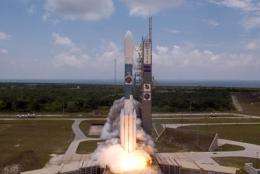Large Area Telescope explores high-energy particles

(PhysOrg.com) -- NASA's Fermi Gamma-ray Space Telescope is making some exciting discoveries about cosmic rays and the Large Area Telescope aboard Fermi is the tool in this investigation. Scientists in the Naval Research Laboratory's (NRL's) Space Science Division were instrumental in the design and development of the Large Area Telescope (LAT).
Cosmic rays are electrons, positrons, and atomic nuclei that move at nearly the speed of light. Astronomers believe that the high-energy cosmic rays originate from exotic places in the galaxy, such as the debris of exploded stars.
The LAT is a wide field-of-view imaging telescope, which consists of a tracker that determines the trajectory of the gamma ray or cosmic ray being measured, and an NRL-developed cesium-iodide calorimeter that determines the energy of the incoming ray. A charged-particle anti-coincidence shield helps filter out unwanted signals, such as those produced by background particles. LAT was developed for detecting gamma rays; however, it is also proving to be a great tool for studying the high-energy electrons in cosmic rays.
Gamma rays travel in straight lines, so scientists are able to pinpoint their sources simply by measuring the direction of each gamma ray as it arrives at the LAT. In contrast, cosmic rays diffuse through our Galaxy, scattering off and spiraling through the turbulent galactic magnetic fields. Because of their movements, scientists find it challenging to determine where the cosmic rays originated. One of Fermi's main goals is determining the sources of cosmic rays.
NRL's highly sensitive LAT measured the energies of more than four million high-energy electrons between August 2008 and January 2009, far more high-energy electrons than have ever been studied before. This extremely large data set allowed scientists to make a precise census of high-energy electrons and led to a surprising excess in the rate of electrons striking the LAT, more than expected from earlier measurements and theoretical models. The LAT data appear to be key to understanding electron measurements made from the European satellite PAMELA and the ground-based High Energy Spectroscopic System located in Namibia.
The Fermi LAT's results indicate that our understanding of the sources and propagation of high-energy particles in the galaxy is incomplete, and they seem to suggest that there is a nearby object beaming cosmic rays in the direction of Earth. Some scientists suggest that a nearby pulsar - the fast-spinning leftover of an exploded star - could be the source sending the electrons and positrons toward Earth. A more exotic possibility is that the particles are evidence of the existence of dark matter. For some time, astrophysicists have suggested that some form of matter - previously undetected and invisible, hence "dark" - exists to provide the extra gravity needed to keep galaxies from whirling apart. While researchers have never directly and conclusively observed dark matter, it could be that the excess electrons LAT observes are the result of interactions or decays of the theorized dark matter particles. Looking ahead, Fermi researchers will be watching for changes in the cosmic ray activity in different parts of the sky. This activity might help them piece together the puzzle in finding the source for the cosmic rays.
Source: Naval Research Laboratory (news : web)




















